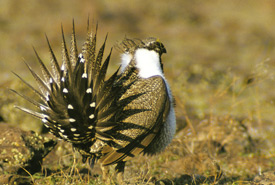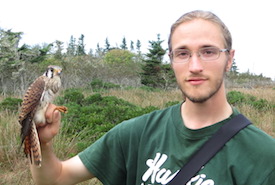So you think you can...mate? Bird edition (Part two)

Greater sage-grouse (Photo by Gordon Sherman © Audubon Canyon Ranch)
The plight of many grassland species, and species at risk in general, has been treated in depth or at least mentioned often over the past few years, including in Land Lines (e.g. “Why Canada’s prairies are the world’s most endangered ecosystem”). I won’t write a treatise on the subject today, but it is a sobering thought.
Several of these declining species are not only fundamentally important, but they are also iconic species either culturally, aesthetically or academically. The evocative displays of the male greater sage-grouse, with tails fanned and air sacs inflated during their communal strut on leks across the sagebrush steppe of southwestern Saskatchewan and southern Alberta, is already relegated to the lore of our parents and grandparents. Only a handful of active leks remain across a sliver of their former Canadian range. These locations are, necessarily, a closely guarded secret among researchers and local landowners, not only to comply with endangered species legislation, but to help keep sacred these last ceremonial haunts and protect them from unintentional and unnecessary disturbance.
The booming aerial display of the common nighthawk, which is not strictly a grassland bird, nonetheless, is disappearing from the summer twilight of the grasslands as it is within their boreal range. As a kid growing up in southwest Saskatchewan, I thought little about how much this species meant to me as I enjoyed its evening displays on many a summer’s eve from my driveway on the outskirts of town as I rolled in from my evening bike ride. It was fascinating, and I enjoyed listening to the sounds and watching the flashes of white on acrobatic wings glowing above the neighbourhood even as the sky turned dark. And then one year, there was silence. I could still find my winged wonders jarring the night silence during an evening hike on the prairie, 50 kilometres away, but that was a bit too far for an evening bike ride.
My favourite grassland bird display is, most unfortunately, also one that is in danger of being lost from Canada’s prairie landscapes. The lilting song and display flight double-feature exhibited by the McCown’s longspur is second to none. Once a common bird across short-grass habitats within the mixed-grass prairies of southern Saskatchewan and Alberta, northward nearly to Saskatoon, my beloved McCown’s longspur is also disappearing from my world.
By the time I started my birding career in the late 1990s, these slate-coloured charms had already been gone from the countryside around Swift Current for nearly a decade. In fact, we were not introduced until a fateful country drive opened my eyes to its fabulously unique plumage in 2003. But I didn’t get to really know this bird and fall head-over-heels in love with it until the summers of 2008 and 2009, as I was surveying for species at risk on the (then) federal community pastures in extreme southwestern Saskatchewan in 2008.
That year, there were still McCown’s longspurs flushing from the roadsides south and west of Consul. Ah, how I remember those June mornings on the prairie, as dawn broke across the skies and the world was filled with the bouncy, lilting trills of my lovely longspurs. Even better than the song itself was watching the dance that accompanied it.
Every time I behold the spectacle, I am immersed in its magic, which still holds me captive like it did that first morning a decade ago. I watched a male vault from a lichen-encrusted rock. He flew into the air, not more than 10 metres or so, and with every lilting trill he floated back down to earth like a leaf or a butterfly on the breeze, with tail fanned and wings outstretched. As the song ended, he returned to his stone perch, not more than a few metres from me, sang a few notes and gave an encore. If I were a female McCown’s longspur…well, let’s just say that I was suitably impressed and leave it at that, okay?
These are the types of moments I look forward to when the birds return each spring. Not just the excitement of them moving en masse across the landscape, or the bright feathers and high diversity, or filling out a long checklist at the end of the day. I live for those magic moments, the ones that take me out of the present and into a timeless window of observation where I forget about life’s stressful minutiae and glimpse the minutiae of life, if for a fleeting moment.
Two years ago I returned to my area west of Divide after several years’ absence, and no birds sang. Okay, so there were several birds, but only a few McCown’s longspurs. During my morning’s search, I could count each one and not run out of fingers. Oh, they are still around here and there, but the distribution is becoming sparser and the pockets fewer, as what’s left from a wider population still holds on along the fringes of Saskatchewan. Will this, too, like the dance of sage-grouse become a vanishing act with no encore?


